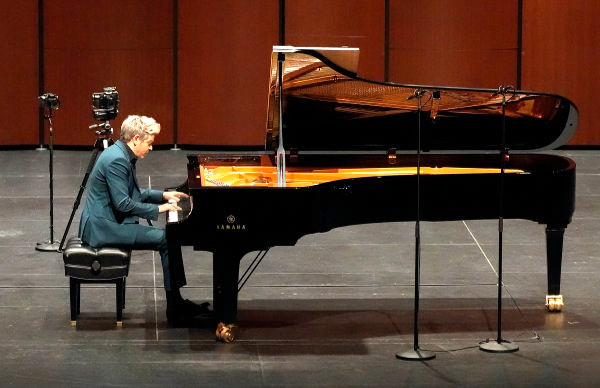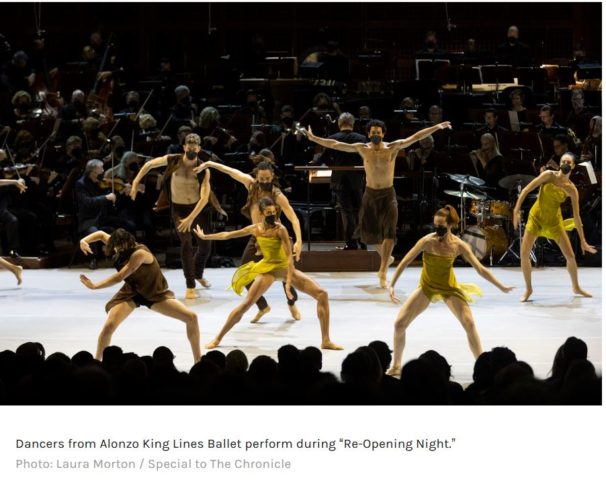Classical music notes …
Esa-Pekka Salonen‘s departure after “helming” the Los Angeles Philharmonic for 17 years was sad. I’m not over it! But at least he’s been tucked away, out of range, in faraway London. Now, in a shock to the classical music world and a great coup for the city of San Francisco, he is the new music director and principal conductor of the San Francisco Symphony. Yes, the Finnish-born Salonen, no stranger to chilly climes, has opted for Northern California — two words that send a shiver down this southern girl’s spine.
My Los Angeles ‘Esa-Envy’ was piqued, truly pierced, in learning that for his first act in the gala re-opening of the SFS season on Friday, October 1, he placed the svelte dancers of San Francisco’s Alonzo King LINES Ballet right on the stage with the orchestra. How I would yearn to be there! The dance opportunity arose from a fascinating crossover of dance and music history.
Alonzo King LINES Ballet performing King’s vigorous choreography for four sections from [Alberto] Ginastera’s 1941 ballet Estancia (Ranch). The origin of the work was a commission from the Lincoln Kirsten-George Balanchine American Ballet Caravan (forerunner of New York City Ballet) given to Ginastera, Brazil’s Francisco Mignone, and Chile’s Domingo Santa Cruz — all choreographed by Balanchine but not performed because the Ballet Caravan disbanded. Ginastera extracted the four sections performed by SF Symphony, called Danzas del Ballet Estancia.
Quoted from “Esa-Pekka Salonen’s First SF Symphony Gala is Like No Other,” Janos Gereben for Classical Voice SF
[We recently enjoyed Alonzo King LINES Ballet at Segerstrom Hall in Orange County, my review here.]
[Esa-Pekka Salonen will conduct the Colburn Orchestra in an upcoming concert at The Soraya Saturday November 13.]

Meanwhile, here in the deep south, a classical-music concert of a more intimate nature took place this week. It was musically large. The vastly gifted concert pianist, the Israeli-born Ory Shihor, is a local treasure who was a longtime professor of piano at The Colburn School of Music and now heads his own teaching institute. A dapper dresser known for his outre hair stylings, on Thursday evening, Shihor brought “Beethoven: Darkness and Light” to the Wallis Annenberg Center for the Performing Arts.
Shihor based his all-Ludwig program on a solid premise. It is the idea that amidst the internal workings of four piano sonatas two aspects of the composer’s psyche, if you will, struggle therein. Shihor references “inevitable darkness” and “luminous light.” Two of the program’s works are the very familiar Moonlight and Appassionata sonatas; the other two, lesser known .
The evening started bumpily, as Shihor seemed to veer out of time in the first moments of Sonata No. 27 in E minor, Op. 90. But we were all out of practice, so it’s possible that my ears were broken. Feathers were smoothed in the more rollicking second movement. Concluding this first work with a pregnant pause, in delicious quiet, Shihor delved directly into Sonata No 14 in C sharp minor, Op. 27, No. 2, the Moonlight.
After an artist’s break (the audience remained in place), the pianist returned for the ruminating opening notes of Sonata No. 12 in A flat major, Op. 26, which segues first into a near dirge, then pitches into a resolute plundering of the piano. The concert concluded with the showpiece Appassionata, Sonata No. 23 in F minor, Op. 57, with its prodigious outpouring of arpeggios — and that nutty “presto” tempo-change at the end of the first bit, which just seems demonic.
It was during the third work that the concert turned the corner not so much into a marathon, which it was, but into a transcendent, shared experience bonding artist with audience by dint of this glorious music. Shihor crossed the finish line with gusto. The marathon, it seemed, was on the audience’s side.
The intensity of receiving so much sound flowing in real time from the stage was exhilarating. Shihor’s concert, originally scheduled for April 2020, was one of the first COVID cancellations before the full Spring season 2020 went down the hatch. While most of us passed 18 months fretting over Netflix versus Hulu, Shihor could rest in the uneasy knowledge that his personal scaling of this mountain of extremely challenging repertoire was still in his future. So I found his survival, let alone his supreme artistic achievement in completing his unfinished task under such circumstances, to be most inspiring.


